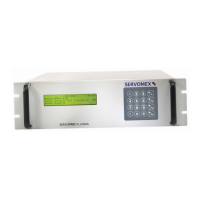User Manual SERVOPRO PLASMA Trace N
2
Analyzer
APPENDIX 8
1. User Manual
This User Manual applies to both versions of SERVOPRO PLASMA analyzers, i.e. Argon or Helium. Since the most popular
version is Argon, all published manuals refer to Argon as background gas. You have to replace the word Argon by Helium when
you are reading this manual.
2. Flow Control System
The flow control valve used in the SERVOPRO PLASMA trace Nitrogen analyzer for Helium background is the same as used in
the Argon version. This valve is not a tight shut off valve. Its purpose is to maintain the flow at the default flow set point, i.e. 75
sccm. It is possible to have a little flow (usually not more than 10 sccm for inlet pressure of 10 psig) with a flow set point value
of 0 sccm. You don't have to worry about that, it is normal phenomenon. Also, please notice that the plasma is shut off when the
real flow is below 10 sccm. The analyzer should be operated and calibrated with a flow set point of 75 sccm and stable inlet
pressure. The recommended inlet pressure range is between 5 to 15 psig, ideal being 10 psig.
3. Leaks
The most critical point in trace Nitrogen analyzer is to avoid the pollution of the sample stream. The leak integrity of the sampling
and calibrating system is critical for the performance of the analyzer, no doubt can subsist about that. Be aware that leaks are
more critical with Helium than Argon. Furthermore, the sample must be as dry as possible. You should use a molecular sieve 3A
trap to keep the sample dry.
4. Working with Helium
It is a challenge to work with Helium in an on line continuous measurement of ppm N
2
. The Helium molecule size and weight are
so small compared to N
2
that special attention must be paid to the sampling system in order to get a better stability.
With Argon, the sampling system operating condition may produce good results. The same condition applied with Helium can
lead to unacceptable performance.
Most of the time, when sampling Helium, if line temperature pressure and flow vary, reading will also vary. The stabilization
time with Helium is much longer than with Argon. Here is why; an often overlooked factor in response speed and signal stability
(or the statistic distribution of N
2
molecule in Helium) is the molecular weight of the carrier gas (Helium in this case) relative to
the impurity to be measured (Nitrogen). Because Helium gas has a small molecular mass, it is difficult matter for them to move
heavier Nitrogen molecules out of the system. So as a rule of thumb, when sampling Helium, do the following:
Keep a constant and high flow rate in the sampling line. Exhaust the excess flow through a by-pass rotometer.
Close to sample point tap or connection, use a small stainless steel electropolish with VCR connection only pressure
regulator. The by-pass rotometer with its valve will fix the line flow and the sample point pressure regulator will maintain the
line pressure constant.
The third parameter: temperature. If the line temperature varies, reading will also vary due to change in equilibrium
conditions, change in temperature when sampling Helium will cause reading drift and recovery time will be long if sample
flow is low. The best result is achieved if you can heat trace the sampling line and maintain the temperature between 60°C to
75°C. The temperature must be constant.
Install the supplied trap at the analyzer inlet.
Use only electropolish stainless steel. Electropolishing is an electrochemical procedure that satisfies the deficient ionic sites of
surface metallic molecules. These ionic sites strongly attract polar molecules causing a stronger adsorption effect at that site.

